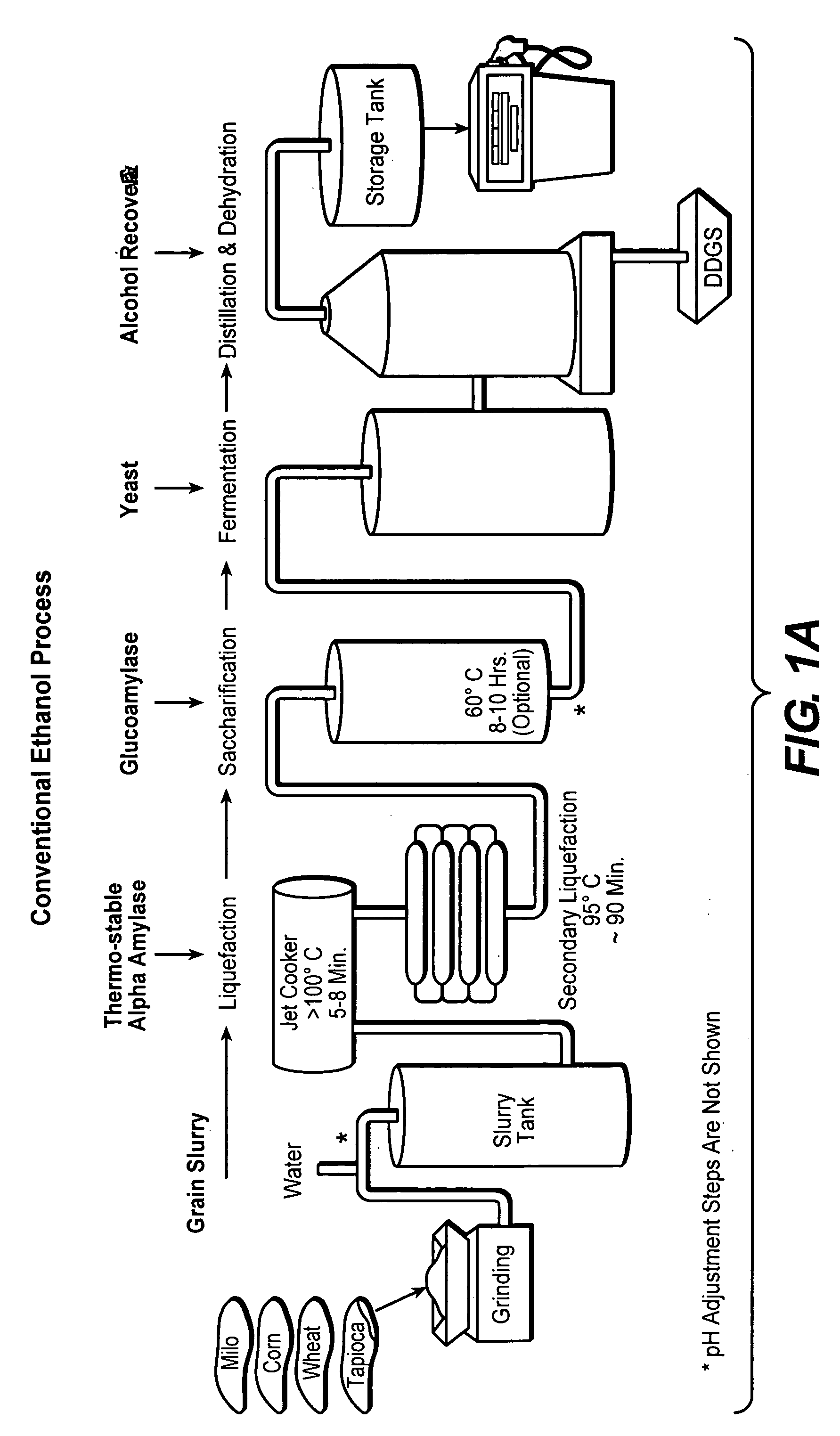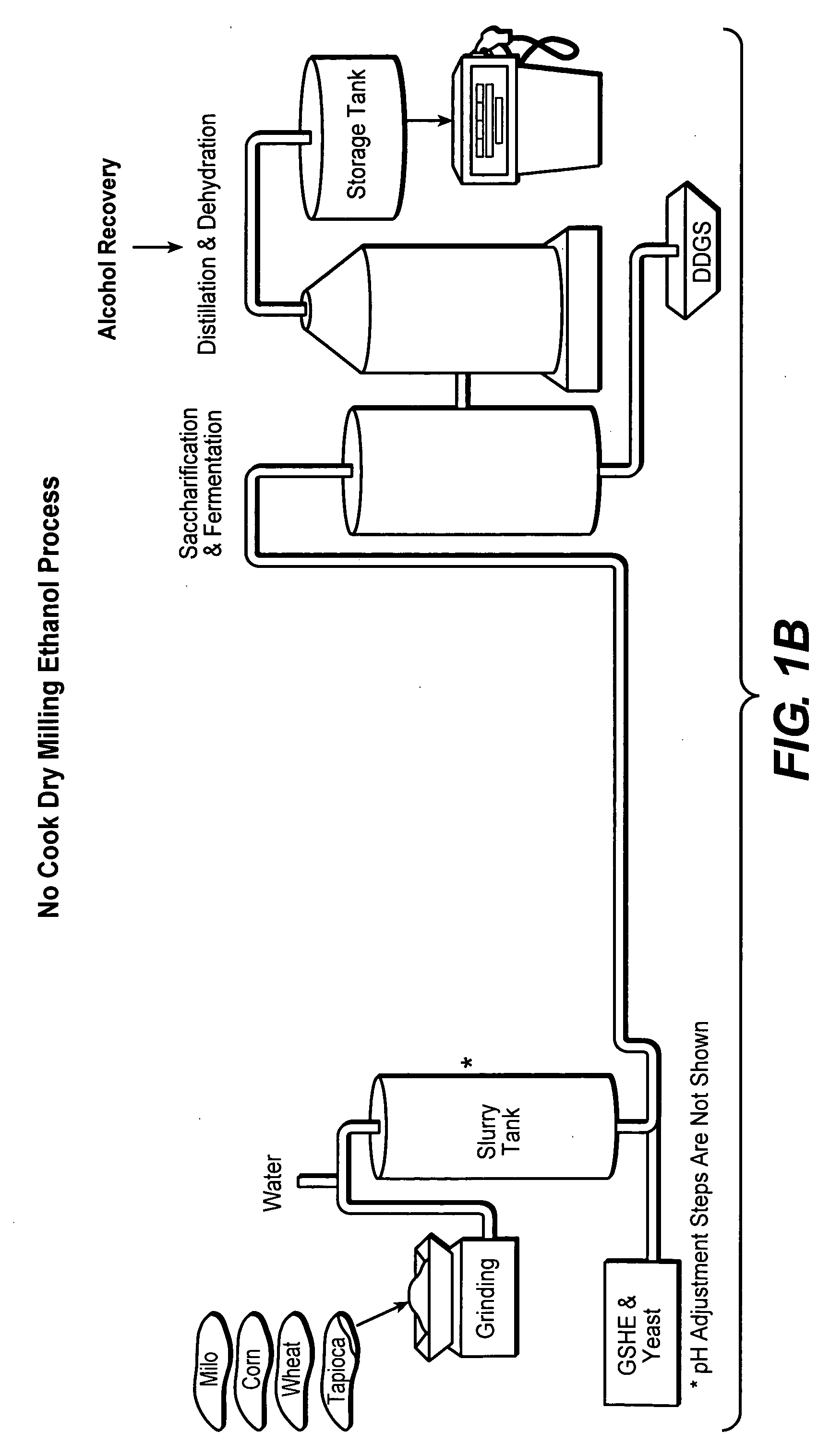Dry solids staging fermentation process
a technology of dry solids and fermentation process, applied in the direction of fermentation, biofuels, etc., can solve the problems of reducing bacterial growth, and achieve the effect of reducing bacterial contamination
- Summary
- Abstract
- Description
- Claims
- Application Information
AI Technical Summary
Benefits of technology
Problems solved by technology
Method used
Image
Examples
example 1
[0189] Five hundred (500) g of finely ground corn (having 14% moisture, a particle size wherein 100% passed through a 40 mesh sieve which is equivalent to 0.420 mm (ASTM), 30% deoiled germ with a starch content of 40%, total starch content of 67%, CR Ethanol, Zhaodong, Heilongjiang, China) was added to a 2-liter bioreactor containing 1.0 liter of distilled water and equipped with a temperature and pH control programming system. Dry urea was added at 1000 ppm. The pH was adjusted to pH 4.5 using dilute sulphuric acid. After uniform mixing and temperature stabilization (30° C.), AnGA / AkAA was added at 0.75GAU / g DS and followed by the addition of dry yeast (0.8% Fali Yeast, Ah Cheng, Heilongjiang, China), and urea (0.1%, Wuxi Minfeng, Wuxi, China). The fermentation medium was continuously stirred to avoid the settling of the ground corn. Samples of fermentation broth were taken at different time intervals and centrifuged. The composition of reaction products was dete...
example 2
Dry Solids Staging Process with Loading of Dry Ground Corn
[0191] The fermentation was carried out as described above with the following differences. The bioreactor was initially charged with ground corn at 15% DS (half of the accumulated DS of the fermentation), AnGA / AkAA at 0.75GAU / g based on a final 30% DS. The fermentation was conducted at 30° C. Starting at approximately 22 hours after commencing initial fermentation, dry ground corn (15.4 g) was added at hourly intervals for 16 hours (total fermentation time =38 hours). Fermentation was continued until 72 hours. The composition of reaction products of the supernatant was analyzed by HPLC and residual starch was determined at 72 hours.
TABLE 2Reaction products from fermentation with loading of dry ground cornSuccinicLacticAceticTimeDP > 3DP-3DP-2DP-1AcidAcidGlycerolAcidEthanolhrs% w / v% w / v% w / v% w / v% w / v% w / v% w / v% w / v% v / v60.260.030.050.360.070.050.870.062.69210.200.030.020.050.110.090.790.057.94250.220.040.020.030.120.090.77...
example 3
Dry Ground Cereal Grain Feeding during the Loading Step and Effect of Initial DS
[0194] Fermentations were carried out as described above in example 1, but with different starting DS. Degermed ground corn from CR Ethanol, Zhaodong, Heilongjiang, China was used which passed 100% thru a 40-mesh screen. In a 2- liter biorector, 816 to 830 grams of the ground corn based on the moisture content, (meaured using a Sartorius AG Gottingen MA 30-00V3), and 1400 or 1500 grams of tap water were mixed and 0.1 % of urea based on the DS was added. The pH of the slurry was adjusted to pH 4.7 using 26% sulphuric acid. AnGA / AkAA was added at 1.0 GAU / g DS based on a final DS of 30%. The bioreactor was inoculated with 0.8% DS dry Angel yeast (Hubei Angel Yeast Co. Ltd, China). The fermentation medium was mixed at slow agitation at 30° C. The initial DS was adjusted to 7, 10 and 15%. The AnGA / AkAA was added based on a final 30% DS. Starting at 15 hours, dry solid ground corn was added directly to the fe...
PUM
| Property | Measurement | Unit |
|---|---|---|
| temperature | aaaaa | aaaaa |
| pH | aaaaa | aaaaa |
| temperature | aaaaa | aaaaa |
Abstract
Description
Claims
Application Information
 Login to View More
Login to View More - R&D
- Intellectual Property
- Life Sciences
- Materials
- Tech Scout
- Unparalleled Data Quality
- Higher Quality Content
- 60% Fewer Hallucinations
Browse by: Latest US Patents, China's latest patents, Technical Efficacy Thesaurus, Application Domain, Technology Topic, Popular Technical Reports.
© 2025 PatSnap. All rights reserved.Legal|Privacy policy|Modern Slavery Act Transparency Statement|Sitemap|About US| Contact US: help@patsnap.com



